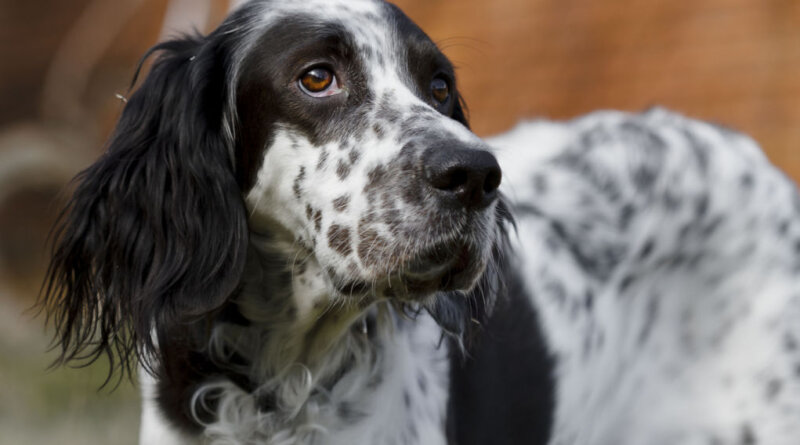English Setter Dog Breed Profile – Top Dog Tips
Would an English Setter make the ideal pawed partner for me?
Well, say no more if you’re an adventure junkie who especially enjoys running and hiking!
We’re excited to introduce this dog breed as it has so much wonderful to offer—from its elegant and unique physique to its extremely high levels of vigor and intellect.
Ready to meet this dog?
Then let’s get right into it.
In this article, you’ll learn about the English Setter’s characteristics, temperament, living needs, interesting facts, and more!
English Setter Dog Brief History
The English Setter’s origin dates back about 400-500 years. Setters became popular in England during the 1960s, 70s, and 80s.
As the name “setting dogges” suggests, Setters were originally bred to set or point highland birds for hunting.
According to evidence, the English Setter dog is thought to have descended from the cross between the Springer Spaniel and the Spanish pointer.
It is sometimes referred to as the Llewellin Setter or Laverack Setter.
This results from the work of two UK citizens from the 19th century named Edward Laverack and Richard Purcell Llewellin.
Both of them started breeding specific kinds of English Setters.
Laverack curated a large show dog. On the other hand, Llewellin was in charge of the ideal dog for hunting.
American Kennel Club says English setter breeds were brought to America in the 19th century.
The first nine breeds registered in the country in 1878 were also members of this breed.
The Llewellin Setter Characteristic
Beauty is work, and the English setter is no exception.
They have sculpted heads and athletic bodies, but they also have a stunning flare. Their well-feathered ears, tail, and underbelly will surely win you over.
Hunting with Llewellin Setter is sure fun. But they’re not only for hunting and dog shows.
They’re so sweet and gentle that they’re even called the “gentlemen of the dog world,” fitting right in with your family.
Seriously, you really need to know more of these amazing facts about the English Setter dog!
Appearance
Have you seen an elegant-looking dog?
English setters have an overall elegant appearance despite having athletic bodies.
If you’ve never seen one, this image will show you what I mean.
To begin with, you will notice the thick feathering on their underbelly and tail. They also almost resemble Dalmatians with their shaggy, hanging ears and colored speckling.
Regarding color, it has become famous for its “white-ground” coloring, which is accentuated by darker hairs. They also come in blue, white, and brown tricolor varieties.
Typically, male setters measure 24 to 26 inches at the shoulder, compared to females’ 22 to 24 inches.
Litter Size
They typically give birth to about 6 English setter puppies. At this stage of their growth, their distinctive features still need to develop fully.
You should give these puppies 15 to 20 minutes of playtime once fully weaned.
Go for walks together, or they can play with different toys.
Life Expectancy
An English setter has a 12-year average lifespan. However, they can begin to show their age around nine.
English setter dogs are prone to serious health problems, so if you’re thinking about getting one, you best be aware of this.
We’ll go through it in further detail in the following sections.
The English Setter Temperament
English setters are good-natured, sensible, and devoted companions. They’re also gentle with children, making them excellent house dogs.
They’re lively, as one would expect from a sporting dog.
But don’t worry! Not to the point of exhausting you.
To be more specific, they can make the perfect jogging and hiking dog partner. This dog breed will be a wonderful companion if you enjoy physical activity.
The English Setter dog is an excellent choice if you want a smart doggo. This dog’s memory is an outstanding aspect of its intellect.
They are also keen to show off their abilities, whether hunting in the field or playing at home.
Fun fact: An English setter has some level of fame. There’s even a beer company named after this breed: English Setter Brewing Company.
Well, I’m guessing the founder is fond of this dog breed.
Caring and Grooming an English Setter
Llewellin Setters need weekly grooming and bathing to maintain their healthy, silky hair—also to avoid tangles developing in their gorgeous coat.
To maintain the sheen of their hair, use a stiff-bristle brush. It also clears away dirt and promotes healthy skin on your dog.
Since English Setters have hanging ears, make sure to check their ears for dirt and debris daily.
Did you know ear infections are more common in dogs with droopy ears?
No?
Well, their ears trap moisture and heat, creating an environment that is ideal for bacterial growth.
In addition, don’t overlook their dental health. Like other breeds, you should brush your Llewellin Setter’s teeth daily. That’s the ideal.
You can find toothpaste and toothbrushes made specifically for dogs online or in nearby stores.
Don’t forget as well to check their mouth for cuts or bleeding gums from time to time.
The Llewellin Setter Health Problems
English setters are generally healthy. But like other breeds, they are susceptible to a few health issues.
Particularly, they can suffer from deafness, hypothyroidism, elbow dysplasia, and canine hip dysplasia (CHD), among others.
Let’s go over these medical issues one by one.
Elbow Dysplasia
Your dog is more prone to pain and arthritis if they have elbow dysplasia.
Currently, 15.3% of Setters submitted to The Canine Health Information Center have this condition.
Elbow dysplasia, according to the Merck Veterinary Manual, is:
“An abnormal development of the elbow joint in young, large, rapidly growing dogs. It involves abnormal bone growth, cartilage development, or joint stresses.”
But because Fido shows minimal symptoms, it can be challenging to make an early diagnosis. However, keep an eye out for any of the following:
- The elbow joint seems tight or limited in its range of motion.
- When the elbow joint moves, you can hear a crackling sound.
- Sometimes, especially after exercise or when first standing up, the dog limps.
Hip Dysplasia
Due to this inherited condition, the thighbone does not fit tightly into the hip joint.
Some dogs might exhibit weakness and pain in one or both of their back legs, but a dog with hip dysplasia may not show any signs of pain.
Although this condition has a genetic basis, environmental factors like injuries and rapid growth from a high-calorie diet may contribute to its development.
If you’re buying English setter puppies, make sure to request records from the breeder proving the parents’ hip dysplasia inspection.
Congenital Deafness
According to Louisiana State University, dogs’ coloring patterns may be related to congenital deafness.
The chance of your dog being deaf rises when the coat is white. Two pigmentation genes, in particular, are connected to canine deafness.
Specifically found in the piebald gene, which is seen in English Setters, Dalmatians, Bulldogs, Beagles, and Greyhounds.
Ignoring commands, strange vocalizing, confusion, disorientation, and being unresponsive to loud noises are all indicators of deafness in dogs.
Hypothyroidism
This occurs when Fido is not secreting enough of the thyroid hormones.
Your dog won’t be able to absorb nutrients from the food it consumes if these hormone levels are low.
Llewellin Setters have the highest rate of hypothyroidism of any breed, in accordance with Orthopedic Foundation of America Thyroid Database.
VCA Animal Hospitals’ Dr. Krista Williams emphasizes that this illness is treatable but not curable.
The worst aspect is that it affects all of your dog’s organs.
That is why it’s critical to be alert for these symptoms:
- slow heart rate
- cold intolerance
- high blood cholesterol
- very thin to nearly bald hair coat
- dry, dull hair with excessive shedding
- increased dark pigmentation in the skin
Epilepsy
Several breeds, including English Setters, are susceptible to inheriting epilepsy. This breed is known for having trouble controlling seizures.
If you’re curious whether epileptic seizures hurt dogs, the answer is no.
Your dog won’t feel pain during a seizure but might feel confused and fearful.
In fact, the most prevalent neurological condition affecting dogs is epilepsy. According to AKC, it affects about 0.75% of the dog population.
You’ll notice that they aren’t conscious of their surroundings. They might even collapse, drool, or lose consciousness.
Fact: AKC refuted that dogs can swallow their tongues during a seizure attack.
Cancer
English Setters suffer from mast cell tumors. It’s a severe form of skin cancer that resembles various tumors on the skin.
Call a veterinarian as soon as you notice any suspicious lumps or bumps. Early detection and removal are crucial.
In older English Setters, hemangiosarcoma is the common type of cancer to develop.
Hemangiosarcoma forms in your dog’s blood vessels. It can occur anywhere in the body, although the heart, skin, and liver are the most commonly affected.
Allergies
Llewellin Setters are also prone to environmental allergies.
Dogs can develop allergic reactions to dust mites, insect proteins, pollen (from plants, grasses, and weeds), and medications.
English Setters often have this skin allergy called “atopy” or atopic dermatitis.
They become extremely itchy, and the more they scratch, the more damage or secondary illnesses they cause to their skin.
Redness, wheals, crusts, and pustules are present. The face, legs, feet, and ears are the most usually affected areas, but no body part is off-limits.
To identify the root cause, a careful process of elimination is necessary.
Consult your veterinarian for advice on how to treat your English Setter’s allergies.
Bacterial and Viral Infections
Bacterial and viral infections can also challenge your English Setter’s immune system.
These include rabies, parvo, and distemper.
Though vaccinations can prevent the majority of these infections, it’s crucial to understand how they transmit.
Rabies
An infected dog can transmit a rabies virus when their saliva comes into contact with open wounds or mucous membranes in the mouth, nose, or eyes.
For dogs with rabies, mouth foaming is a typical sign. However, other dogs may simply drool or slobber excessively.
As time goes on, your English Setter can get irritated and even be aggressive. However, they could also act unusually affectionate.
Parvovirus
Parvovirus is a highly contagious viral disease that causes puppies to have an acute gastrointestinal illness.
According to Cornell University’s College of Vet Medicine, it usually affects puppies between the ages of 6 and 20 weeks. However, it can also impact older dogs.
Direct dog-to-dog contact and contact with contaminated environments, people, or other animals are the main ways it is transmitted.
Distemper
Distemper is a dangerous illness that spreads easily, just like Parvovirus. Your dog’s respiratory, digestive, and nervous systems are all under attack.
AKC says dogs can get distemper in three ways:
- Through the placenta
- Through airborne exposure
- Through direct contact with an infected animal or object
The initial sign is typically a watery to pus-like discharge from the eyes, followed by a fever and appetite loss.
Obesity
Dog obesity can also pose a serious health risk to English Setters.
Being overweight can reduce life expectancy in dogs.
Health problems, including osteoarthritis, diabetes, and even cancer, are more likely to affect them.
The more your furry child acts adorable, the more it may be tempting to spoil them with food and treats, especially when they gaze into your eyes with such soulfulness.
You might, however, just pat them and give them a belly rub. Engage them in an activity or go for a stroll.
Besides, including physical activity in your dog’s daily routine can be ideal for maintaining your four-legged friend’s weight.
Note: The average healthy weight for female English Setters is between 45 and 50 pounds. Most men weigh between 65 and 70 pounds.
Bleeding Disorders
English Setters and other dog breeds are susceptible to von Willebrand’s genetic blood clotting disease.
Dogs suffering from this condition have von Willebrand coagulation factor (vWf) levels that are less than half normal. The vWf is a protein essential for normal blood clotting.
You’ll notice that your Llewellin Setter may bruise easily, have frequent nosebleeds, and experience mouth bleeding when their baby teeth fall out.
Our four-legged pet often seems normal until a serious injury occurs or they have performed surgery. Then they’ll experience severe bleeding.
English Setter’s Diet and Exercise
The diet should consist of the following for optimal health:
- Fatty acids and omegas
- Protein from quality meat
- Vitamins and minerals from bone and plant sources
- Amounts of carbs from berries, herbs, and vegetables
- High-moisture meals and water are essential for hydration
An important component of caring for your English Setter is providing nutritious meals and keeping them mentally and physically active.
As mentioned, Llewellin Setters are active dogs. They reared and raised them to hunt in grassy areas as gun dogs.
This breed needs over 2 hours of exercise per day. English Setters benefit most from vigorous activities and exercise that is done off-leash.
But it does not require one to be a hunter; rather, activities should resemble those a dog would carry out in the field.
Your pawed pal will enjoy it if you engage them in agility course training.
During this activity, your dog must pass through, around, under, and over various obstacles.
English Setter Dog Breed: 10 Interesting Facts
- With a history dating back to the 14th century, the Llewellin Setter is one of the oldest breeds of gun dogs.
- Both the Irish Setter and the English Setter have extremely similar coats. The English Setter, however, has a wider color range than the red Irish Setter.
- English Setters are typically more difficult to train than Gordon Setters.
- The upland hunting ability of English Setters is inherent. They prefer to hunt for grouse, quail, and pheasants.
- A working/obedience dog with above-average intelligence, the Llewellin Setter was ranked 37th in Stanley Coren’s The Intelligence of Dogs.
- Cancer is the leading cause of death in English Setters. The age of death from this disease was after reaching 10 years of age.
- Reverend A Harrison of Carlisle in Columbia sold Laverack a male dog named “Ponto” and a female named “Old Moll” in 1826. This duo was the foundation of his English Setters.
- The English Setter can be a blue, orange, lemon, or chestnut belton in color.
- Their coat has a white base with different colors of tickling or speckling.
- In general, English Setters from hunting stock have finer frame and a shorter coat than those raised for show exhibition.
English Setter Dog Breed: FAQs
Is an English Setter high-energy?
English Setters are high-energy dogs. They are in-born hunters, so a home with a yard and room to run will appeal to them more.
Take your animal companion for daily walks or runs in the dog park. To stay healthy and happy, they must engage in physical and mental exercise.
How intelligent are English Setters?
Llewellin Setters are very intelligent. You can train them to perform tricks and commands another breed can do.
But keep in mind that because they are a sensitive and stubborn breed, they need gentle and patient training.
What are English Setters known for?
The English Setter is a friendly and gentle dog that gets along with kids. They are known for being kind toward families and adapt well to most homes.
Also, they can coexist peacefully with cats with the correct introductions. Indeed the gentleman of the doggie world.
How fast is an English Setter?
The Llewellin Setter can run three to five miles fairly quickly. You can hike five to seven miles with it as well.
You’ll surely enjoy their company as your jogging and hiking partner. Bring extra water for everyone and make sure there are breaks in between.
English Setter Dog Breed: In a Nutshell
The English Setter from field lines will not only give you the most fun time of your life.
Apart from this breed’s energetic and intelligent nature, you’ll also adore its tenderness and how it excels with children.
Who among dog lovers wouldn’t be proud to be seen walking around with a gorgeous English Setter?
From the feathering they carry to their perfect size and stunning colors, this dog will surely capture everyone’s attention.
These wonderful attributes that an English Setter can bring into your life have the power to change it as well—excitingly and positively!
If you want to know more about setter dog breeds, you might want to check the next article for another type of setter dog breed.
READ NEXT: Irish Setter Dog Breed Profile








